24.9: Climate Change
- Page ID
- 17822
\( \newcommand{\vecs}[1]{\overset { \scriptstyle \rightharpoonup} {\mathbf{#1}} } \)
\( \newcommand{\vecd}[1]{\overset{-\!-\!\rightharpoonup}{\vphantom{a}\smash {#1}}} \)
\( \newcommand{\dsum}{\displaystyle\sum\limits} \)
\( \newcommand{\dint}{\displaystyle\int\limits} \)
\( \newcommand{\dlim}{\displaystyle\lim\limits} \)
\( \newcommand{\id}{\mathrm{id}}\) \( \newcommand{\Span}{\mathrm{span}}\)
( \newcommand{\kernel}{\mathrm{null}\,}\) \( \newcommand{\range}{\mathrm{range}\,}\)
\( \newcommand{\RealPart}{\mathrm{Re}}\) \( \newcommand{\ImaginaryPart}{\mathrm{Im}}\)
\( \newcommand{\Argument}{\mathrm{Arg}}\) \( \newcommand{\norm}[1]{\| #1 \|}\)
\( \newcommand{\inner}[2]{\langle #1, #2 \rangle}\)
\( \newcommand{\Span}{\mathrm{span}}\)
\( \newcommand{\id}{\mathrm{id}}\)
\( \newcommand{\Span}{\mathrm{span}}\)
\( \newcommand{\kernel}{\mathrm{null}\,}\)
\( \newcommand{\range}{\mathrm{range}\,}\)
\( \newcommand{\RealPart}{\mathrm{Re}}\)
\( \newcommand{\ImaginaryPart}{\mathrm{Im}}\)
\( \newcommand{\Argument}{\mathrm{Arg}}\)
\( \newcommand{\norm}[1]{\| #1 \|}\)
\( \newcommand{\inner}[2]{\langle #1, #2 \rangle}\)
\( \newcommand{\Span}{\mathrm{span}}\) \( \newcommand{\AA}{\unicode[.8,0]{x212B}}\)
\( \newcommand{\vectorA}[1]{\vec{#1}} % arrow\)
\( \newcommand{\vectorAt}[1]{\vec{\text{#1}}} % arrow\)
\( \newcommand{\vectorB}[1]{\overset { \scriptstyle \rightharpoonup} {\mathbf{#1}} } \)
\( \newcommand{\vectorC}[1]{\textbf{#1}} \)
\( \newcommand{\vectorD}[1]{\overrightarrow{#1}} \)
\( \newcommand{\vectorDt}[1]{\overrightarrow{\text{#1}}} \)
\( \newcommand{\vectE}[1]{\overset{-\!-\!\rightharpoonup}{\vphantom{a}\smash{\mathbf {#1}}}} \)
\( \newcommand{\vecs}[1]{\overset { \scriptstyle \rightharpoonup} {\mathbf{#1}} } \)
\( \newcommand{\vecd}[1]{\overset{-\!-\!\rightharpoonup}{\vphantom{a}\smash {#1}}} \)
\(\newcommand{\avec}{\mathbf a}\) \(\newcommand{\bvec}{\mathbf b}\) \(\newcommand{\cvec}{\mathbf c}\) \(\newcommand{\dvec}{\mathbf d}\) \(\newcommand{\dtil}{\widetilde{\mathbf d}}\) \(\newcommand{\evec}{\mathbf e}\) \(\newcommand{\fvec}{\mathbf f}\) \(\newcommand{\nvec}{\mathbf n}\) \(\newcommand{\pvec}{\mathbf p}\) \(\newcommand{\qvec}{\mathbf q}\) \(\newcommand{\svec}{\mathbf s}\) \(\newcommand{\tvec}{\mathbf t}\) \(\newcommand{\uvec}{\mathbf u}\) \(\newcommand{\vvec}{\mathbf v}\) \(\newcommand{\wvec}{\mathbf w}\) \(\newcommand{\xvec}{\mathbf x}\) \(\newcommand{\yvec}{\mathbf y}\) \(\newcommand{\zvec}{\mathbf z}\) \(\newcommand{\rvec}{\mathbf r}\) \(\newcommand{\mvec}{\mathbf m}\) \(\newcommand{\zerovec}{\mathbf 0}\) \(\newcommand{\onevec}{\mathbf 1}\) \(\newcommand{\real}{\mathbb R}\) \(\newcommand{\twovec}[2]{\left[\begin{array}{r}#1 \\ #2 \end{array}\right]}\) \(\newcommand{\ctwovec}[2]{\left[\begin{array}{c}#1 \\ #2 \end{array}\right]}\) \(\newcommand{\threevec}[3]{\left[\begin{array}{r}#1 \\ #2 \\ #3 \end{array}\right]}\) \(\newcommand{\cthreevec}[3]{\left[\begin{array}{c}#1 \\ #2 \\ #3 \end{array}\right]}\) \(\newcommand{\fourvec}[4]{\left[\begin{array}{r}#1 \\ #2 \\ #3 \\ #4 \end{array}\right]}\) \(\newcommand{\cfourvec}[4]{\left[\begin{array}{c}#1 \\ #2 \\ #3 \\ #4 \end{array}\right]}\) \(\newcommand{\fivevec}[5]{\left[\begin{array}{r}#1 \\ #2 \\ #3 \\ #4 \\ #5 \\ \end{array}\right]}\) \(\newcommand{\cfivevec}[5]{\left[\begin{array}{c}#1 \\ #2 \\ #3 \\ #4 \\ #5 \\ \end{array}\right]}\) \(\newcommand{\mattwo}[4]{\left[\begin{array}{rr}#1 \amp #2 \\ #3 \amp #4 \\ \end{array}\right]}\) \(\newcommand{\laspan}[1]{\text{Span}\{#1\}}\) \(\newcommand{\bcal}{\cal B}\) \(\newcommand{\ccal}{\cal C}\) \(\newcommand{\scal}{\cal S}\) \(\newcommand{\wcal}{\cal W}\) \(\newcommand{\ecal}{\cal E}\) \(\newcommand{\coords}[2]{\left\{#1\right\}_{#2}}\) \(\newcommand{\gray}[1]{\color{gray}{#1}}\) \(\newcommand{\lgray}[1]{\color{lightgray}{#1}}\) \(\newcommand{\rank}{\operatorname{rank}}\) \(\newcommand{\row}{\text{Row}}\) \(\newcommand{\col}{\text{Col}}\) \(\renewcommand{\row}{\text{Row}}\) \(\newcommand{\nul}{\text{Nul}}\) \(\newcommand{\var}{\text{Var}}\) \(\newcommand{\corr}{\text{corr}}\) \(\newcommand{\len}[1]{\left|#1\right|}\) \(\newcommand{\bbar}{\overline{\bvec}}\) \(\newcommand{\bhat}{\widehat{\bvec}}\) \(\newcommand{\bperp}{\bvec^\perp}\) \(\newcommand{\xhat}{\widehat{\xvec}}\) \(\newcommand{\vhat}{\widehat{\vvec}}\) \(\newcommand{\uhat}{\widehat{\uvec}}\) \(\newcommand{\what}{\widehat{\wvec}}\) \(\newcommand{\Sighat}{\widehat{\Sigma}}\) \(\newcommand{\lt}{<}\) \(\newcommand{\gt}{>}\) \(\newcommand{\amp}{&}\) \(\definecolor{fillinmathshade}{gray}{0.9}\)This image represents the biggest problem that the human species has ever faced: the current trend in global warming. There is no longer any doubt that our planet is growing warmer and that human actions are the primary cause. There is also no question that if we don’t do something about it soon, the consequences will be devastating. Of the 17 warmest years on record, 16 of them have occurred since the year 2000. While record-breaking years attract the most public attention, individual years are less significant than the overall trend, and the upward trend in Earth’s temperature is alarming. The average temperature of the planet has been rising for more than a century, and its rate of increase is accelerating. The most significant reason for Earth’s rising temperature is the human impact on the greenhouse effect.
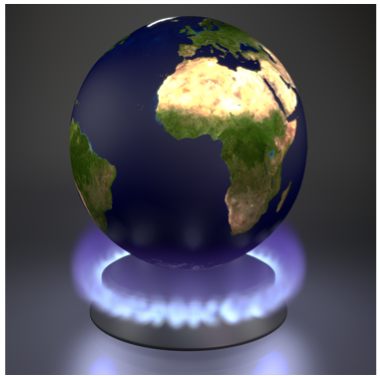
The Greenhouse Effect
The greenhouse effect is the process by which the atmosphere of a planet such as Earth warms the planet’s surface to a temperature above what it would be without the atmosphere. The atmosphere raises the surface temperature if it contains certain gases — called greenhouse gases — that can radiate energy down to the planet’s surface.
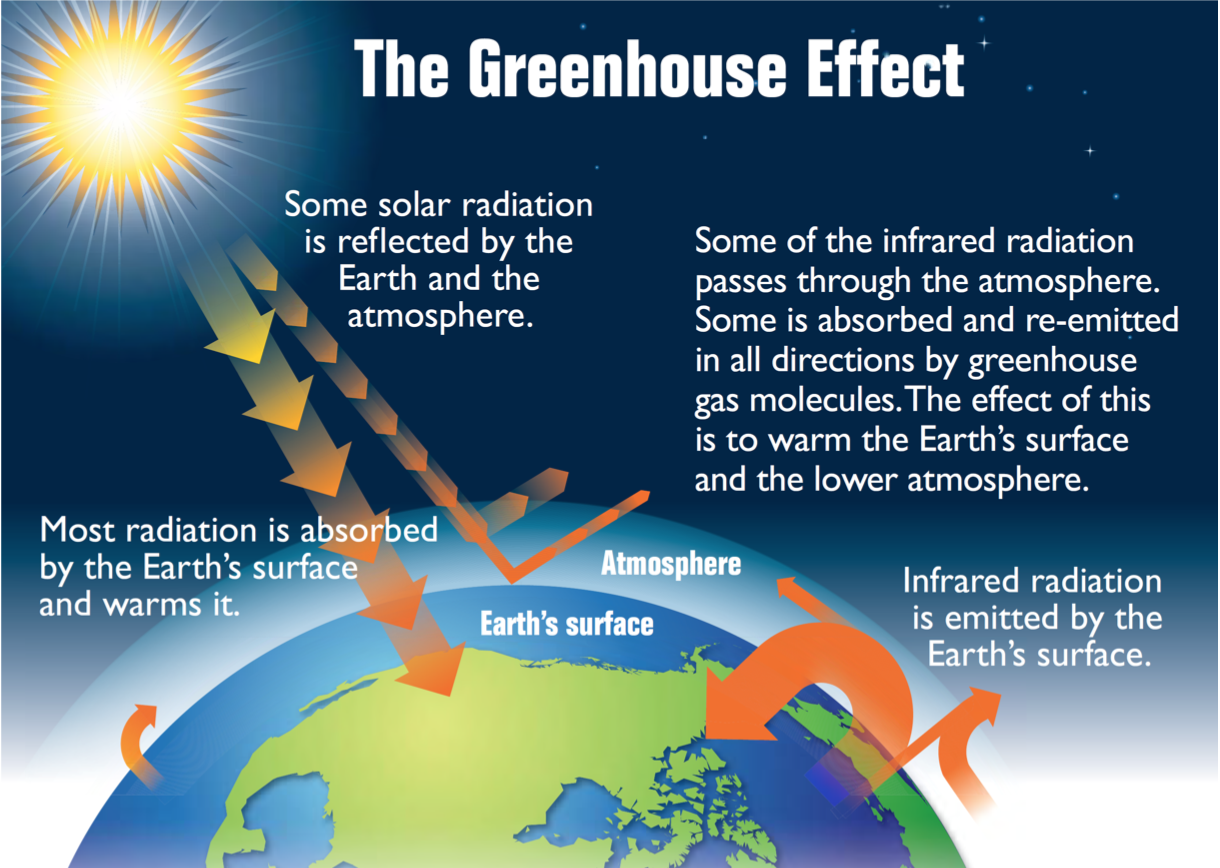
How does the greenhouse effect work? As shown in Figure \(\PageIndex{2}\), of the total amount of solar energy available at the top of the atmosphere, some of the energy is reflected back into space by the atmosphere or Earth, and some is absorbed by the atmosphere and clouds. However, most of the energy is absorbed by Earth’s surface, and much of this energy is radiated back into the atmosphere as infrared radiation, which we feel as heat. If this radiation is absorbed by greenhouse gas molecules in the atmosphere, it is re-emitted by the molecules in all directions. The effect is to warm Earth’s surface and the lower atmosphere.
Earth’s natural greenhouse effect is critical to supporting life on the planet. Without the greenhouse effect, Earth’s average temperature would be about -18 degrees C (0 degrees F), as compared with the present average of 15 degrees C (59 degrees F). However, human activities have intensified the natural greenhouse effect by increasing greenhouse gas concentrations in the atmosphere. This is known as the enhanced or anthropogenic greenhouse effect, and it is causing global warming.
Greenhouse Gases
Greenhouse gases are radiatively active gases, meaning they can absorb and re-radiate infrared energy. They include all gases with three or more atoms. As shown in Table \(\PageIndex{1}\), the top three greenhouse gases in Earth’s atmosphere are carbon dioxide (CO2), hydrofluorocarbons (HFCs), and methane (CH4). The table also lists the main human activities that contribute to greater concentrations of these and other greenhouse gases in the atmosphere.
| Gas | Production | |
|---|---|---|
| 60% | \( CO_2 \nonumber\) Carbon dioxide * | Burning fossil fuels, deforestation |
| 16% | \( HFCs \nonumber\) Hydroflurocarbons | Aerosols, refrigerants |
| 15% | \( CH_4 \nonumber\) Methane * | Organic waste, cattle, fuel production |
| 5% | \( N_2O \nonumber\) Nitrous oxide | Fertilizer, soil, fuels |
| 2% | \( PFCs \nonumber\) Perfluorcarbons | Paint, textile and aluminum production |
| 1% | \( SF_6 \nonumber\) Sulfur hexafluoride | Electrical industry, rubber/MG production |
| 1% | \( H_2O \nonumber\) Water vapour * | Irrigation, evaporation, ice melting |
The Importance of Carbon Dioxide
As Table \(\PageIndex{1}\) shows, the major greenhouse gas in terms of its effect on climate is carbon dioxide. How much a greenhouse gas contributes to the enhanced greenhouse effect and global warming depends on how well it radiates heat and also on its abundance and persistence in the atmosphere. Although HFCs and methane are much more potent radiators of heat than carbon dioxide, carbon dioxide is much more abundant and lasts far longer in the atmosphere.
Sources and Sinks of Carbon Dioxide
Carbon dioxide enters Earth’s atmosphere largely through the burning of fossil fuels. Coal produces twice as much carbon dioxide as natural gas, with oil being intermediate. Currently, about half of the carbon dioxide released from the burning of fossil fuels remains in the atmosphere. The rest is taken up by plants (for photosynthesis) or dissolved by seawater. Deforestation reduces the total amount of carbon dioxide that is absorbed by plants, thereby increasing the amount of carbon dioxide that remains in the atmosphere.
Global Climate Change
Climate change, in general, refers to any change in average weather conditions on Earth that lasts for at least several decades. Short-term perturbations in climate, such as El Niño events, are not considered to be climate change. Earth’s climate has repeatedly changed in earlier epochs because of natural disturbances, such as massive volcanic eruptions and movements of continents. Over the past couple of centuries, the most important cause of climate change has been human actions, which are causing an enhanced greenhouse effect and global warming.
Evidence of Global Climate Change
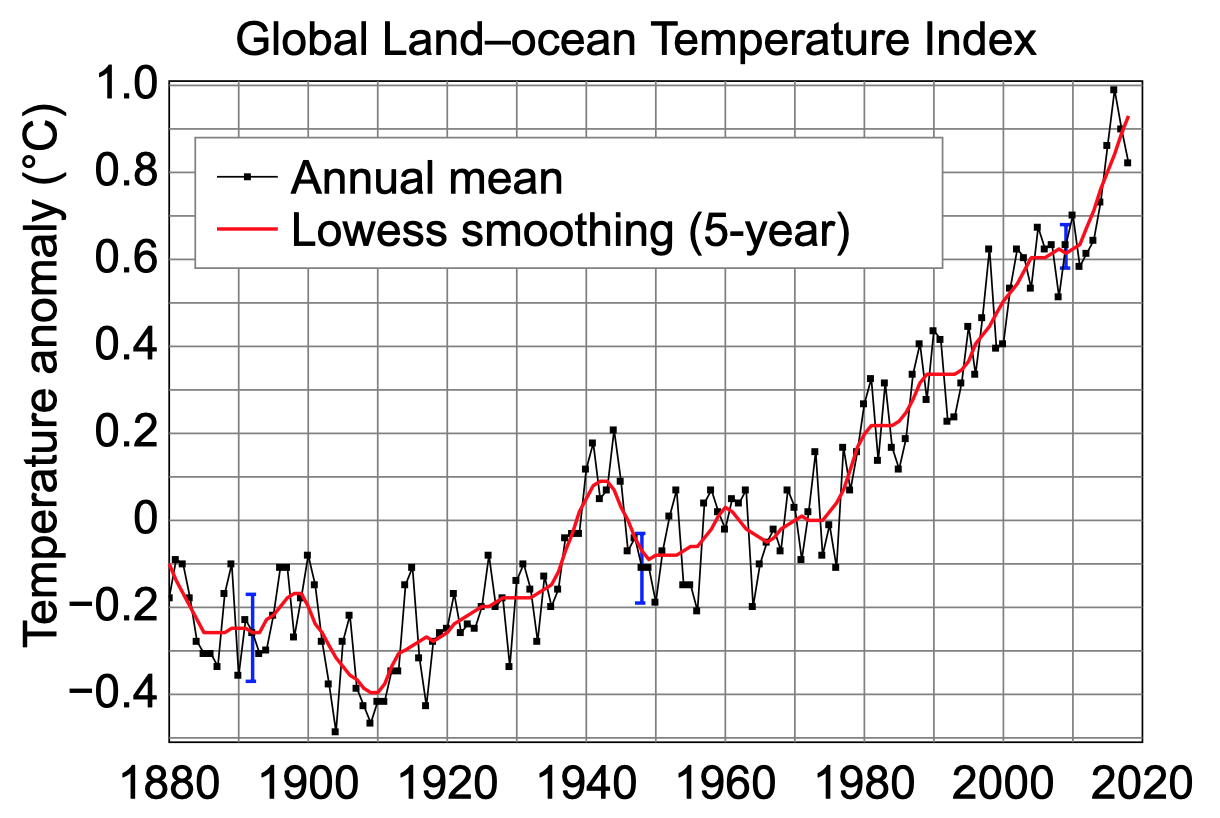
Evidence for global warming comes from a variety of sources. Reasonably complete direct measurements of global surface temperatures are available beginning in the late 1800s. The graph in Figure \(\PageIndex{3}\) shows how the annual mean temperature of Earth’s land and the ocean has deviated from baseline values (set at the mid-20th century). Relative to this baseline, earlier temperatures were generally cooler, and more recent temperatures have been consistently warmer. Overall, the graph shows a long-term warming trend.
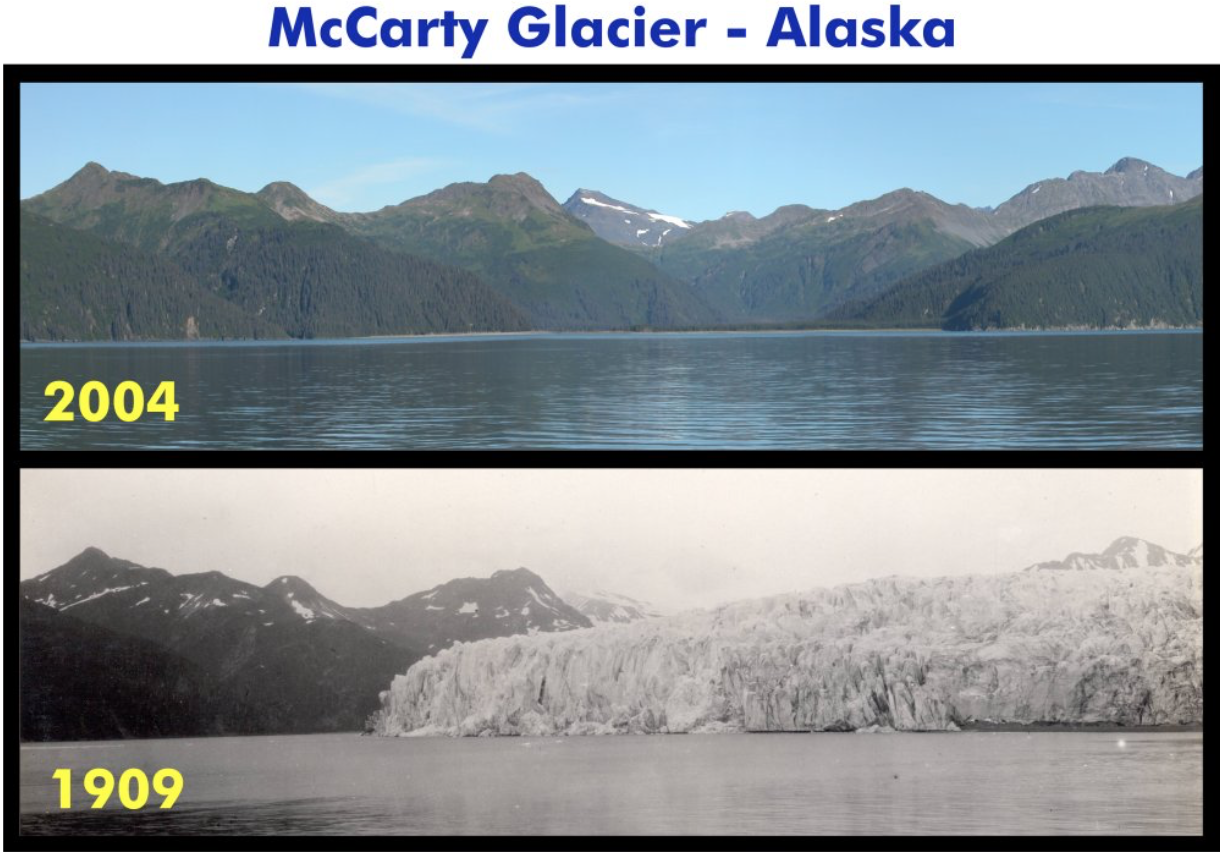
Less direct but equally convincing evidence of recent global warming is the shrinking of glaciers and polar ice fields. As an example, Figure \(\PageIndex{4}\) shows changes in the McCarty Glacier in Alaska. The bottom photo shows the large McCarty Glacier as it appeared in the summer of 1909. The top photo shows that the glacier had completely disappeared in the summer of 2004.
Projections of Future Climate Change
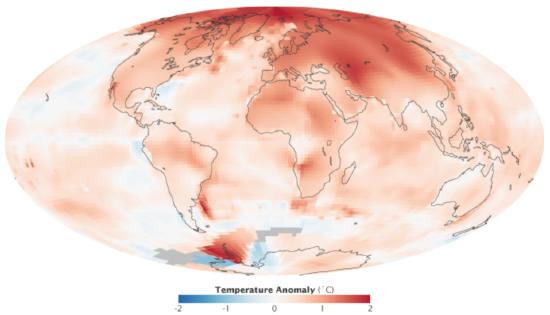
Unless energy policies change substantially, the world will continue to depend on fossil fuels and greenhouse gas emissions will remain high. Greenhouse gases already present in the atmosphere will persist for decades or even centuries, so they will continue to influence Earth’s climate long into the future. This will be the case, regardless of any steps that are taken to reduce greenhouse gas emissions going forward.
Depending on assumptions about future greenhouse gas emissions, climate models predict that the mean global surface temperature is likely to rise by 0.3-4.8 degrees C (0.5-8.6 degrees F) before the temperature levels off. Future climate change is also predicted to differ from region to region around the globe (Figure \(\PageIndex{5}\)). Warming has been and will continue to be greater over land than over the ocean because water has a greater capacity than land to absorb heat. Warming also has been and will continue to be greater in the Arctic than anywhere else on Earth for reasons that are not yet fully known.
Impacts of Future Global Warming
Future global warming is projected to have a wide range of impacts besides increases in temperature alone. They include continued retreat of glaciers and polar ice sheets, greater frequency, and severity of extreme weather events such as droughts, expansion of deserts, and changes in agricultural production. The increase in temperature will also cause a shift toward the poles in terrestrial plant and animal ranges as well as irreversible impacts on particular ecosystems, including tundra and coral reefs. Overall, it is expected that climate change will result in the extinction of many species and reduced diversity of ecosystems. Even the frequency of human violence, including violent crimes and warfare, is expected to increase as Earth’s temperature rises. Increased violence is likely because of the worsening of many underlying problems — greater water shortages and crop failures, worse poverty and hunger, higher rates of disease, and displacement of people due to weather disasters and habitat destruction.
One reason habitats will be destroyed is a rise in sea level. Sea level is already rising and will probably continue to rise for centuries because of an increase in the volume of water in the ocean. The water volume will increase because of the continued melting of ice sheets and glaciers as well as the natural expansion of water as it warms. The average sea level could rise by as much as 2.3 meters for each degree Celsius of temperature increase. The map in Figure \(\PageIndex{6}\) shows coastal areas that would be underwater if the sea level were to rise by an average of 6 meters, which would occur if the mean global surface temperature rose by about 2.6 degrees C. Many of the world’s largest and most densely populated cities are located in low-lying coastal areas. If these areas were inundated by the ocean, it would cause the displacement of hundreds of millions of people and nearly unfathomable economic losses.
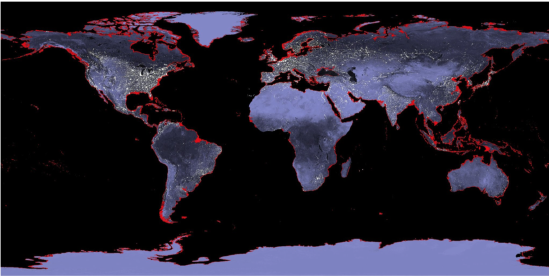
Potential Solutions to Climate Change
Most climate experts agree that future global warming should be limited to less than 2.0 degrees C. Otherwise, greater global warming would have catastrophic impacts and eventually exceed the capacity of natural and human systems to adapt. Controlling global warming requires first and foremost deep cuts in greenhouse gas emissions. International organizations and national governments have adopted resolutions and policies with this goal, the most important of which is promoting the use of renewable energy resources instead of fossil fuels. Other approaches to greenhouse gas control include increasing the amount of carbon removed from the atmosphere, for example, through the protection of forests and reforestation programs.
Review
- Define the greenhouse effect.
- Explain how the greenhouse effect works.
- Why is the natural greenhouse effect necessary for life on Earth?
- What are greenhouse gases?
- How have human actions enhanced the natural greenhouse effect?
- List the top three greenhouse gases in Earth’s atmosphere in terms of their effect on climate.
- Why is carbon dioxide the most significant cause of the enhanced greenhouse effect? How does carbon dioxide enter the atmosphere?
- Describe how atmospheric carbon dioxide concentrations have changed over the past millennium.
- Define climate change.
- Identify the main cause of recent and ongoing climate change on Earth.
- Describe direct and indirect evidence for global warming.
- Outline spatial variation in global warming.
- How much is the global surface temperature predicted to increase in the future? Give the range of values based on climate models. What factor is mainly responsible for the variation in model projections? What is the greatest increase in temperature that most climate experts recommend avoiding the most catastrophic effects of global warming?
- Identify several potential impacts of future global warming.
- What is the single most important way to control global warming?
- Which activity causes the most carbon dioxide to be emitted into the atmosphere?
- The burning of coal
- Exhalation by mammals
- The burning of natural gas
- The burning of oil
- The sea level could rise by approximately how much if the global temperature increases by 4.8 degrees.?
- 4.8 meters
- 6 meters
- 8 meters
- 11 meters
Explore More
Watch these videos to learn about sustainability
Attributions
- Earth on stove by Lesserland, CC0 via Wikimedia Commons
- Greenhouse Effect by US EPA, public domain via CK-12 Foundation.
- Global temperature anomaly by NASA Goddard Institute for Space Studies, public domain via Wikimedia Commons
- Comparison photos of McCarty Glacier in Kenai Fjords National Park, Alaska. by USGS, public domain via Wikimedia Commons
- GISS temperature 2000-09 by NASA image, public domain via Wikimedia Commons
- 6m Sea Level Rise by NASA, public domain via Wikimedia Commons
- Text adapted from Human Biology by CK-12 licensed CC BY-NC 3.0


